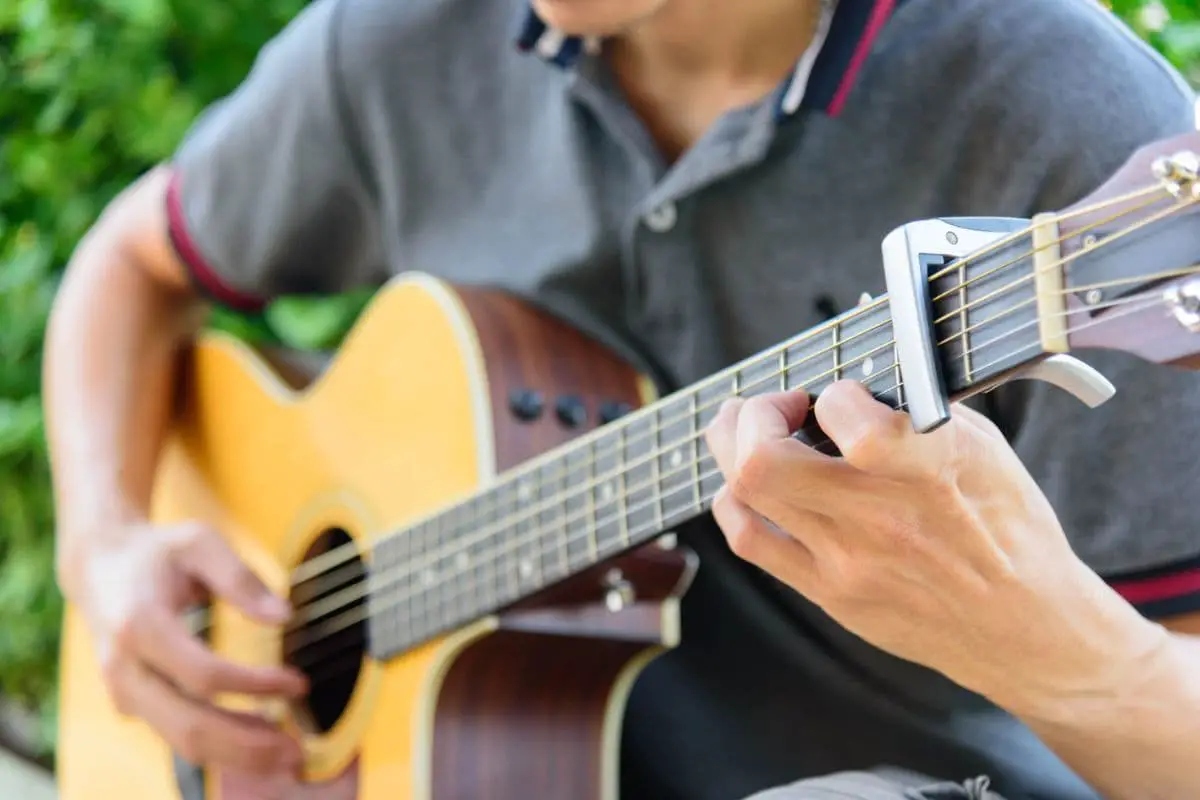Using a capo is one of the best ways to change your guitar sounds without barring the frets. Not only does it free your hands to perform new chords, but it also raises the pitch. However, music theory can be quite complicated. Adding a capo into the mix changes all of the chords. But is it enough to alter the way you play the guitar?
Chords change by one semitone per fret when you add a capo. For example, a G chord becomes a G sharp, an A chord becomes an A sharp, and so on. You can change your chord shapes to make the same sounds you’re used to playing without a capo. Make sure you remove the capo when you’re done.
In this post, we’ll break down what a capo does to your guitar chords, how you can use it to your advantage, and why some capos affect your guitar’s intonation.
If you want to find out what my recommended guitar gear is, then here is what I recommend on Amazon:
- Fender Cutaway Acoustic-Electric Guitar Bundle (MY FAVORITE GUITAR)
- Snark SN-8 Super Tight All Instrument Tuner (Easiest Tuner I’ve Used)
- 6 String Acoustic Guitar Capo (Best CAPO for quick changes)
- Dunlop Max Grip 1.0mm Nylon Picks (Thick Guitar Pick So You Don’t Lose Grip!)
- Universal Guitar Stand (Cheap & Minimalist Guitar Stand I Recommend)
- Levy’s 2″ Wide Quick Adjust Guitar Strap (Best Guitar Strap For Any Level)
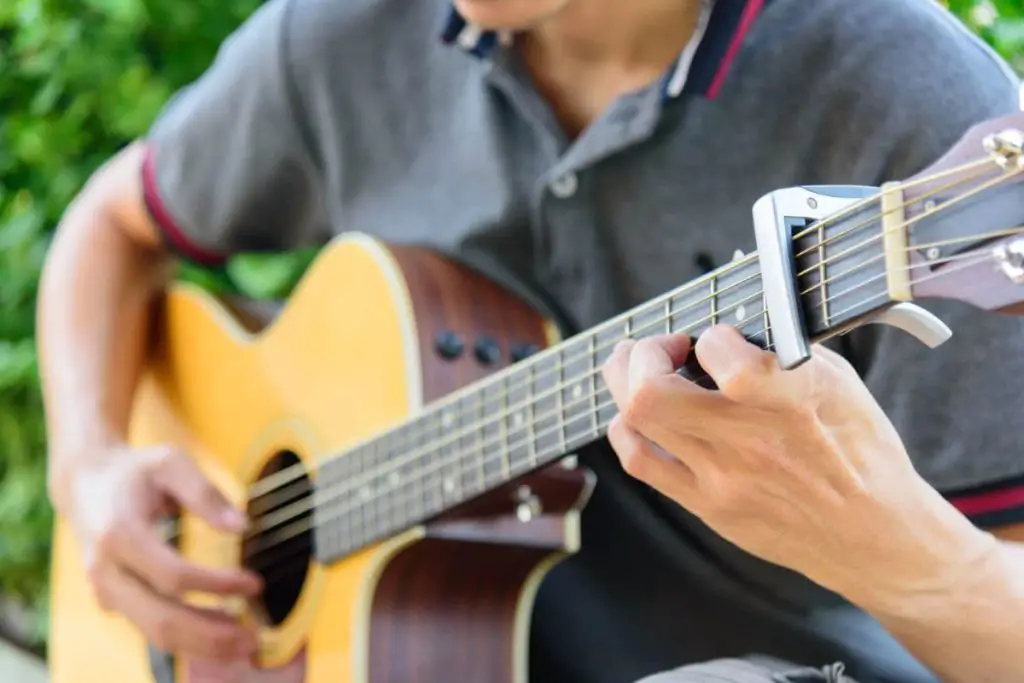
What is a Capo and How Does a Capo Change Chords?
A capo makes your guitar sound higher pitched by increasing the semitones. Every fret is one semitone increase, so everything will go up the higher you move up the fretboard. It’s important to know that the sound doesn’t just get a little higher; The chords you play will require different hand positions.
Capos can change everything about the way you play the guitar. Whether you have an acoustic guitar, an electric guitar, or a bass guitar, capos make everything unique and fun. It’s best to stick to one fret once you know which one you prefer the most. Switching around too often will make you have to constantly relearn the chords.
Don’t let that worry you, though. Below, we’ll break down everything you need to know about changing your chords when you attach a capo to any guitar.
How Do You Change Guitar Chords With a Capo? How To Use A Capo
To change guitar chords with a capo, follow these instructions:
- Play a major chord (such as a C Major) without a capo. C chords are made with an E, C, and G. Play this chord anywhere on the fretboard (preferably as close to the headstock as possible). Keep each position on the string in mind to know where you’re supposed to place your fingers. For example, the E would become an E sharp with a capo on the first fret.
- Place the capo on the first fret and play the chord with the same C Major shape. You’ll notice the C Major chord sounds familiar but a bit higher. You can use this chord in the same position or switch it to follow the aforementioned E C G pattern. However, this new sound won’t technically be a C Major.
- Go up one fret with the capo for every semitone (half note) you want to increase the chords. You can use this pattern to form brand-new hand positions for each chord. Just for reference, your chord positions will look completely different when you add a capo. Again, you can keep the same position if you enjoy the tone.
- Try numerous capo frets until you like whichever one you land on. Many well-known songs have a capo on the second fret. However, you can play those same songs on any fret. Keep in mind that the key will be different, but the song will simply sound higher pitched than usual.
- Find your favorite chords on the new fretboard. Try the capo chord chart by Live About. It contains all of the chord changes you need to know before using a capo. Transfer any of your desired songs to a different sound with the same chords. This process takes a little while, but it’s more than worth it.
We recommend moving up a fret until you find one that makes all of your favorite chords as easy as possible. You can also keep the same chord positions while moving the apo up the fretboard to create new, engaging chords. Playing up the fretboard adds countless unique renditions to your music.
Does a Capo Make Chords Easier?
A capo makes chords easier because it reduces the tension required, you don’t have to stretch your fingers as far to reach the strings, and there’s no need to bar the frets. Furthermore, adding a capo to your guitar lets you play plenty of professional songs that require higher octaves while producing a clearer melody.
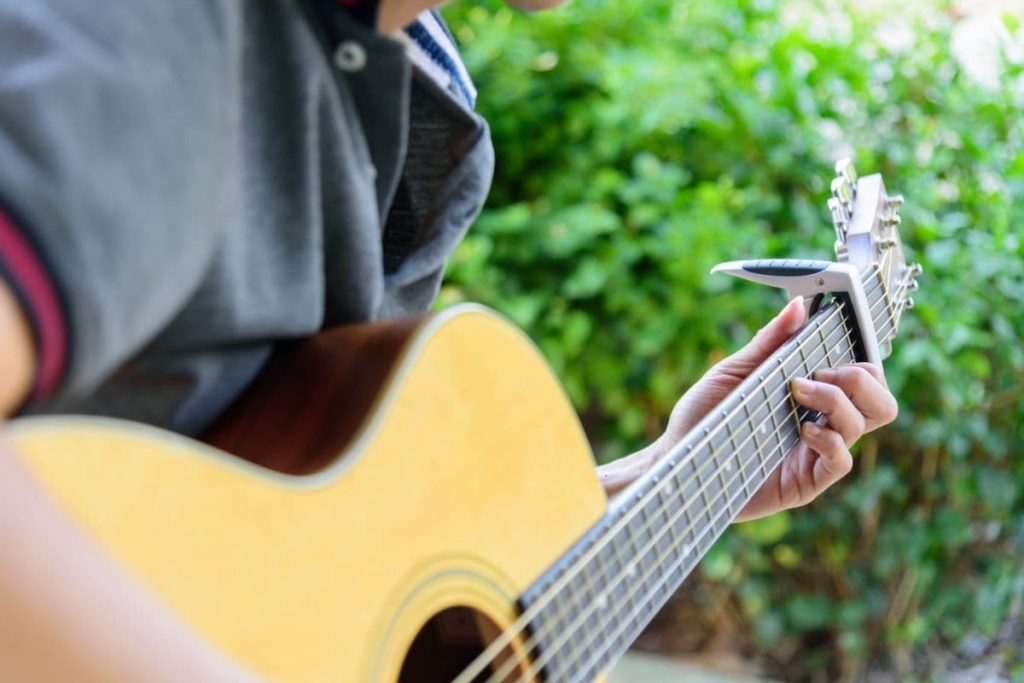
Here’s a detailed breakdown of each of these reasons:
- Reduced tension required: According to Guitar Domination, you don’t need to push as hard on the strings because they’re closer to the bridge. Most strings get easier to compress the further down the neck you go. If you’re having trouble fretting the chords, a capo can work wonders.
- Less stretching your fingers: Beginners often find it difficult to stretch their hands in the awkward angles required for some chords. However, using a capo means there’s less space to cover. The frets get narrower as you move up the fretboard. Placing the capo higher on the fretboard makes this much easier.
- No need for barred frets: Barring frets is one of the most challenging parts of learning the guitar. Rather than barring a fret, you can place a capo over the fret and keep your hands free. Once you get used to the sounds you need to produce, you can transition to playing bar chords without a capo.
- Higher octaves: An octave is every 12 frets on the fretboard. If you want to play in a higher octave, all you have to do is put the capo on the 12th fret. You can use this to layer your music when recording it through an audio interface. There are plenty of songs that are an octave above standard tuning.
- Clearer, brighter tones: When you play with thinner strings, they’re quite bright and bouncy. The same thing happens when you move up the fretboard with a capo. You can use this tip to test one song on multiple frets to see which one sounds the best to you.
Capos are great for beginners, but they also provide various benefits to advanced guitarists. If you’re interested in learning what a capo can do for your guitar, read on.
What Is the Advantage of a Capo?
The advantages of using a capo include the following:
- Using a capo can help you improve your guitar tapping techniques. You don’t have to apply as much pressure to the strings, not to mention the fact that they’re much close as you move up the fretboard. These combined benefits make tapping a breeze compared to trying it without a capo.
- You don’t have to change the tuning to play in a higher key if you have a capo. Some people switch their guitar tuning when they want to play new songs. However, you can keep the instrument’s tuning and add a capo to keep yourself from having to go back and retune it when you’re done.
- Capos let you match other instruments, including ukuleles, mandolins, and pianos. Many people play duets. If you want to play with someone who has a ukulele, place the capo on the fifth fret. You’ll have the same pitch, helping you blend your music with everyone in the group rather than having too much bass.
- Adding a capo can help you match your vocal pitch. If you have a high-pitched voice, you might have a hard time making it sound good with a standard guitar tuning. Instead, place the capo on the fretboard and keep going down the neck until you find the pitch that pairs well with your voice.
- Capos lessen the vibrations coming from the strings, which makes the instrument slightly quieter. Whether you’re playing the guitar in an apartment or you don’t want to disturb your neighbors, you can use a capo to reduce its sound output. You’d be surprised by how much quieter a guitar sounds with a capo on the 10th fret.
There are countless advantages to having a capo. It’s another tool to learn and enjoy with the guitar. However, proper maintenance is required if you want to prevent long-term damage. In the following section, we’ll explain why it’s important to know where and how to store your capo to protect the tool and the guitar.
Is It Okay to Leave a Capo On the Guitar?
It’s okay to leave a capo on the guitar for a few hours, but try not to store it with the capo on it for too many days. When the capo is left on a guitar for too many days or weeks in a row, it stretches the strings and weakens the spring in the capo. This means it’ll end up buzzing the strings rather than fretting them.
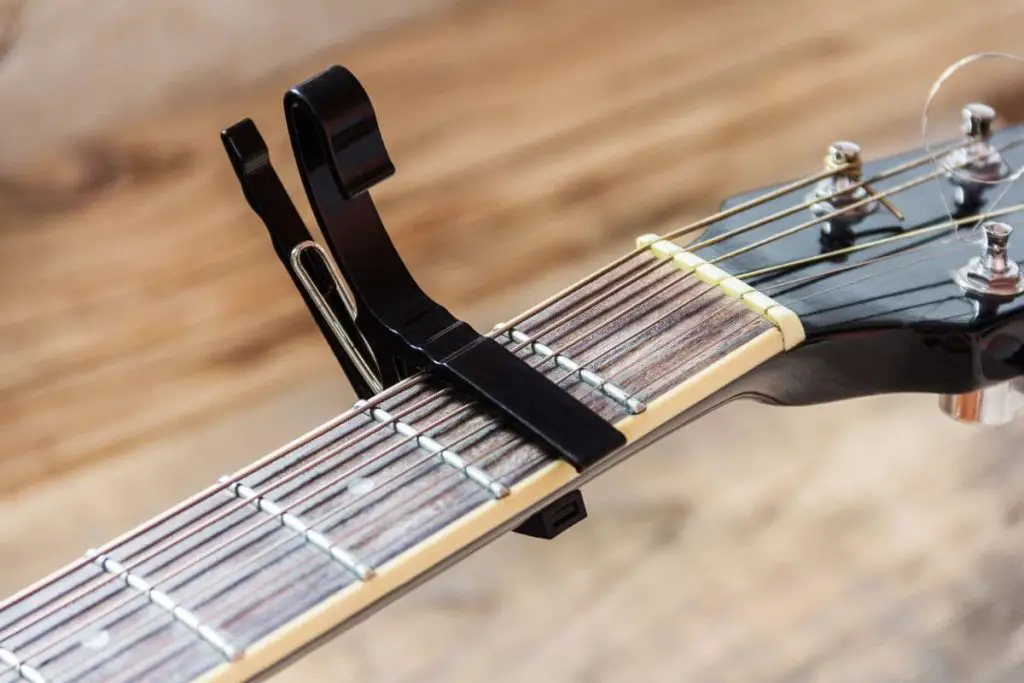
Let’s take a deeper look at why you shouldn’t leave a capo on a guitar below.
- Your capo’s spring can wear down. One of the quickest ways to ruin a capo is to leave it open for too long. It’s fine to keep the capo on your guitar for a little while, but the spring needs to be able to expand to its original length every so often. Once this happens, you’ll either have to replace the spring or get a new capo.
- The strings will get weak spots wherever you leave the capo. Guitar strings aren’t supposed to be bent for too long. If you hold them against the fretboard with a capo for several weeks in a row, the strings will develop stress spots. These spots can buzz, sag, and snap the strings down the road.
- Capos can stain the guitar if they’re left on the instrument for long periods of time. While it won’t affect the way your guitar sounds, this issue can make your guitar and capo look a little unsightly. A capo stain looks like a discolored bar wrapped around whichever fret the capo was on for too long.
- Your capo’s foam or rubber padding will indent and become less effective. The padding is designed to protect the strings. Once it wears away, the pad won’t be able to prevent the strings from getting scraped and scuffed. It can also make the guitar sound a bit metallic (people also describe this sound as sharp or tinny).
- The stretched strings will go out of tune. Guitar strings get overstretched when a capo is on the fretboard for too long. These stretched strings have a much higher chance of snapping or losing their intonation. If this happens, it’s time to change the strings and make sure you don’t leave the capo on the fretboard for too long.
Why Does My Guitar Sound Sharp With a Capo?
Your guitar sounds sharp with a capo for many reasons, including the fact that your capo might reduce the action. You could also be getting used to the higher tones coming from the capo or the tinny noise from the reduced vibrations. Nevertheless, playing with a capo when the action is level will help you get used to the sharpness.
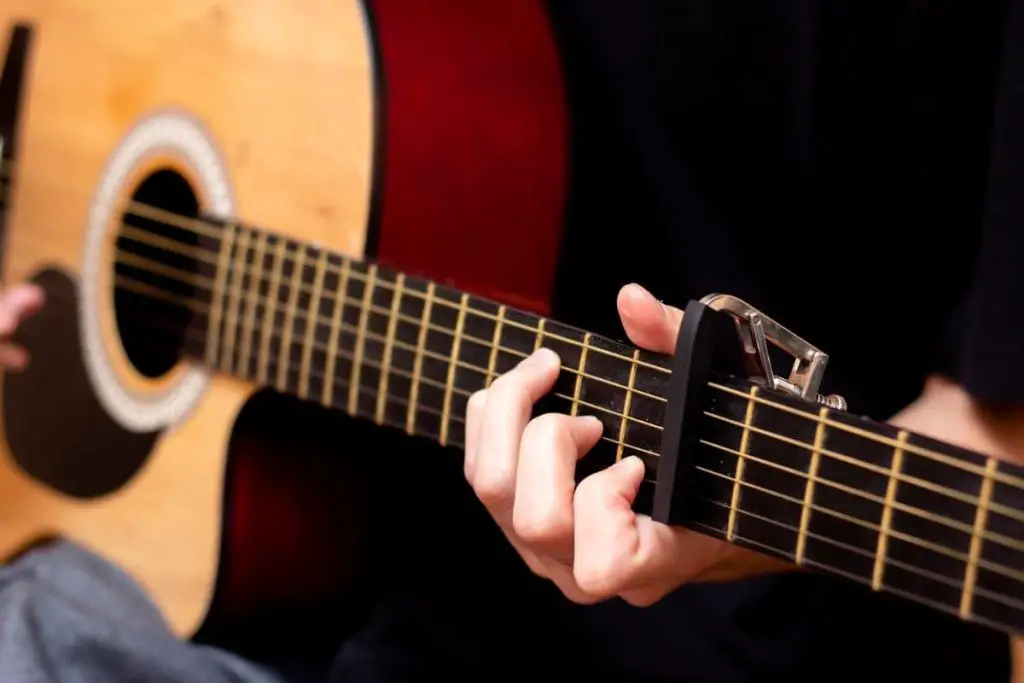
So, what can you do if a capo makes your guitar sound sharp? Try these suggestions:
- If the action is a bit too high, you might not notice it until you add a capo. High action on a guitar makes the strings contact a couple of fret bars, causing them to buzz. The buzzing sounds can mimic tinny, sharp noises. Turn the truss bar with an Allen key to reduce the action until it doesn’t buzz anymore.
- Capos change the nut to whatever material it’s made of. Many guitars have a bone or plastic nuts. If you have a metal capo, the strings will vibrate on the metal capo rather than the plastic nut. You’ll notice the vibrations feel sharper and harsher. You can fix this common issue by switching to a plastic capo.
- Shorter strings naturally sound higher pitched. This is why ukuleles tend to have higher pitches, even if you have a baritone ukulele that’s tuned the same as an acoustic guitar. Placing the capo higher on the fretboard will undoubtedly sound a bit sharper, especially if you play the sharp notes (G sharp, C sharp, etc.).
- Reduced vibrations will reduce the bass, thus highlighting the guitar’s treble. Guitars get their warm tones from the deep vibrations of the top three strings. If you capo the strings, they won’t resonate or sustain as long. This means you’ll end up with a lot of treble (which many guitarists love the change).
- If the capo is at an angle, it’ll pull the strings too tightly. Make sure the capo is flat against the fretboard. If it’s tilted or slanted, some of the strings will be stretched. Stretched guitar strings have reduced vibrations and very tinny sounds that end up sharpening the noises produced by the sound hole.
Does a Capo Affect Intonation?
A capo can affect intonation for many reasons, including stretching old strings, improper placement, and compressing some of the strings but not others. If you think your capo is affecting your guitar’s intonation, remove the capo and bar the fret. If the intonation is fine on the barred fret, something is wrong with the capo.

That being said, your capo shouldn’t ruin the intonation if it’s working properly. The intonation refers to the guitar’s ability to stay in tune as you move up the fretboard. If your guitar goes out of tune as you apply chords close to the bridge, the intonation is off. Unfortunately, some people only have this happen when they use their capos.
Capos can influence a guitar’s intonation in these ways:
- Strumming Bars explains a capo can wear down the fret if it’s on the same part of the guitar for too long. Worn frets distort the string’s vibrations, ruining the intonation. If this happens to your guitar, apply the capo one or two frets above the damaged fret. This method will let you know if it’s the capo or the worn fret.
- Capos can cause intonation problems if they pull the strings and loosen the bridge pins. When the bridge pins loosen, they can’t hold the strings in the correct tune. Sadly, this issue also wears down the bridge. Keep an eye on the saddle to see if it tilts in a specific direction when you apply the capo.
Proper intonation is a crucial and irreplaceable part of playing the guitar. If your capo ruins your instrument’s intonation, it’s worth getting a new one or trying one of the previously mentioned solutions. Sometimes, changing the action can make a world of difference. Remember to try everything with and without the capo to know if it’s the source of the problem.
Final Thoughts On How Do Chords Change With A Capo
Adding a guitar to your guitar can add infinite chord possibilities. Not only will you master music theory, but you’ll also find ways to layer your music and make unique sounds. Remember, each fretted capo adds one semitone to the music scale. Use this equation to create your favorite songs and learn new chords with a capo.
What is the correct way to use a capo?
Here are some general guidelines on how to use a capo on your guitar:
- Choose the right capo: There are several different types of capos available, including spring-loaded, trigger-style, and strap-on capos. Choose the one that feels most comfortable to you and that is compatible with your guitar.
- Position the capo correctly: The capo should be placed on the desired fret, close to the fret but not touching it. Make sure the capo is positioned evenly across all the strings to avoid any buzzing or muffled notes.
- Tune the guitar: Once the capo is in place, you may need to retune the guitar. The capo will raise the pitch of the strings, so tune each string to the desired pitch.
- Experiment with different positions: The capo can be used to play in different keys without having to use complicated chord fingerings. Experiment with different capo positions to find the one that works best for the song you are playing.
- Be aware of the sound: While a capo can be a useful tool, it can also affect the tone and resonance of the guitar. Be aware of how the capo is affecting the sound of your playing, and adjust as necessary.
Remember, the capo is a tool that can help you play in different keys and create new sounds on your guitar. With practice, you can learn to use the capo effectively and incorporate it into your playing.
What key does a capo change the guitar to?
A capo does not change the guitar to a specific key but rather raises the key of the guitar. It raises the pitch of the strings, effectively shortening the length of the strings between the capo and the bridge.
For example, if you place a capo on the second fret, you can play the same chord shapes you would normally play in the key of E, but now you will be playing in the key of F# because the pitch of the strings has been raised by a whole step. The actual key you will be playing in depends on where you place the capo on the fretboard and the chord shapes you use.
How do you use a capo for beginners?
Using a capo on your guitar can be a great way to play in different keys without having to learn new chord fingerings. Here are some simple steps for using a capo for beginners:
- Choose the right capo: There are several different types of capos available, including spring-loaded, trigger-style, and strap-on capos. Choose the one that feels most comfortable to you and that is compatible with your guitar.
- Position the capo correctly: The capo should be placed on the desired fret, close to the fret but not touching it. Make sure the capo is positioned evenly across all the strings to avoid any buzzing or muffled notes.
- Tune the guitar: Once the capo is in place, you may need to retune the guitar. The capo will raise the pitch of the strings, so tune each string to the desired pitch.
- Play familiar chord shapes: One of the benefits of using a capo is that you can play familiar chord shapes in a different key. For example, if you normally play a G chord, you can play the same shape with a capo on the third fret to play a Bb chord.
- Experiment with different positions: The capo can be used to play in different keys without having to use complicated chord fingerings. Experiment with different capo positions to find the one that works best for the song you are playing.
Should a beginner use a capo?
A capo can be a useful tool for beginners as well as experienced guitar players. A capo allows you to play in different keys without having to learn new chord shapes, making it easier to play along with other musicians and sing along with songs in different keys. It can also make certain chord progressions easier to play by shortening the distance between the frets.
Using a capo can also help you to develop your ear for different keys and chord progressions, which can be helpful for your overall musical development. As you become more comfortable with the guitar, you can experiment with different capo positions to create new sounds and find the ones that work best for your playing style.
What key is capo 2nd fret?
If you place a capo on the second fret of your guitar, it will raise the pitch of the strings by two half-steps or two semitones. This means that every chord you play will sound two half-steps higher than it would without the capo. For example, if you play a G chord with the capo on the second fret, it will sound like an A chord. Similarly, if you play a C chord with the capo on the second fret, it will sound like a D chord. The actual key you will be playing in depends on where you place the capo on the fretboard and the chord shapes you use.
Do chords change with capo?
When you use a capo on your guitar, the chord shapes you play will remain the same, but the pitch of the chords will change. This is because the capo effectively shortens the length of the strings between the capo and the bridge, which raises the pitch of the strings. The capo allows you to play the same chord shapes you would normally use, but in a higher key.
For example, if you normally play a G chord without a capo, you would play the notes G-B-D. If you place a capo on the second fret and play the same chord shape, you will now be playing an A chord (because the capo raises the pitch by two half-steps). Similarly, if you play a C chord without a capo, you would play the notes C-E-G. If you place a capo on the third fret and play the same chord shape, you will now be playing an Eb chord (because the capo raises the pitch by three half-steps).
So, the chord shapes themselves do not change with a capo, but the actual chords you are playing will be in a different key because of the change in pitch caused by the capo.
How do you tell what key you’re in with a capo?
When you use a capo on your guitar, the actual key you are playing in depends on where you place the capo on the fretboard and the chord shapes you use. One way to determine the key you are playing in with a capo is to identify the note being played on the open strings of the guitar.
For example, if you place a capo on the second fret of your guitar and play a G chord shape, the pitch of the notes you are playing will be raised by two half-steps. The resulting chord will be an A chord, which is two half-steps higher than a G chord. In this case, the open strings of the guitar will be playing the notes A-D-G-B-E (rather than E-A-D-G-B-E, which is the standard tuning for the guitar).
To identify the key you are playing in, simply look at the note being played on the open strings and use that as a starting point. For example, if you are playing with a capo on the second fret and your open strings are tuned to A-D-G-B-E, then you are playing in the key of A (because the note being played on the open strings is A). From there, you can identify the chords you are playing and determine the key of the song or progression.
Why do guitarists use capos?
Guitarists use capos to change the pitch of their guitar without having to relearn the chord shapes they already know. Capos are clamps that attach to the neck of the guitar and hold down all the strings at a specific fret, effectively shortening the playable length of the strings.
Using a capo allows guitarists to play in different keys without having to change the chords they already know, making it easier to play along with other musicians or sing along to songs in different keys. It also allows for the use of open-string chords in different keys, which can create different tonal qualities and harmonic possibilities. Additionally, using a capo can make certain chord progressions easier to play by shortening the distance between frets.
Capos are commonly used in folk, country, and acoustic music, as well as in certain styles of rock and pop music. They can be especially useful for singer-songwriters who want to play songs in keys that suit their vocal range. Overall, the capo is a versatile tool that allows guitarists to explore new tonal possibilities and play in a wider range of keys with ease.
If you want to find out what my recommended guitar gear is, then here is what I recommend on Amazon:
- Fender Cutaway Acoustic-Electric Guitar Bundle (MY FAVORITE GUITAR)
- Snark SN-8 Super Tight All Instrument Tuner (Easiest Tuner I’ve Used)
- 6 String Acoustic Guitar Capo (Best CAPO for quick changes)
- Dunlop Max Grip 1.0mm Nylon Picks (Thick Guitar Pick So You Don’t Lose Grip!)
- Universal Guitar Stand (Cheap & Minimalist Guitar Stand I Recommend)
- Levy’s 2″ Wide Quick Adjust Guitar Strap (Best Guitar Strap For Any Level)
Related Posts:
- 8 Pros and Cons of Using a Guitar Capo
- Can You Use A Capo On An Electric Guitar?
- What Key Is A Guitar In Without A Capo?
- Can You Tune A Guitar With A Capo On? Here’s The Answer
- Why Do Guitarists Use Capos? (And Why You Should Too)
- How To Play Capo Songs Without A Capo: DIY Methods
- Can A Capo Damage Your Guitar Or Strings?
- How To Play Bar Chords On Acoustic Guitar (Easy Beginner Tutorial)
- Cowboy Chords On Guitar: What are they? (Chart, Songs, Tabs)

